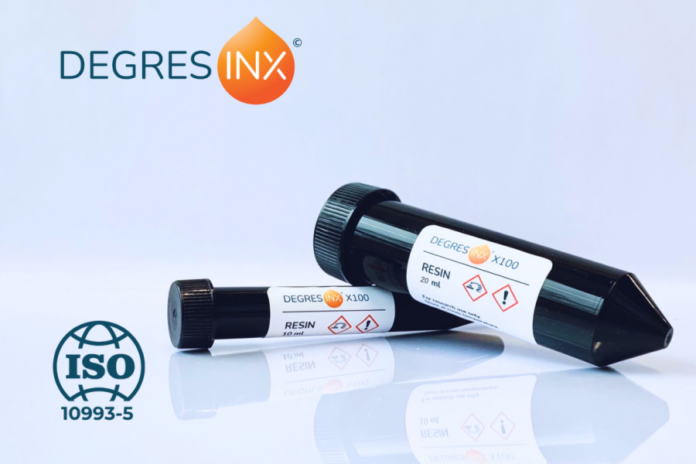BIO INX, a company that specializes in bioink technologies, has developed DEGRES INX, a biodegradable resin with shape memory properties. This material can be deformed into a temporary shape after 3D printing and returns to its original printed shape when heated to body temperature.
Ideal for for digital light projection (DLP) based 3D-(bio)printing, the material is described as “a world first”, as it not only possesses shape memory properties but is also biodegradable and biocompatible (according to ISO 10993-5 standards). This means that the resin is suitable for cell cultivation after 3D printing.
BIO INX explains that the material is polyester-based, making it biodegradable. Additionally, it has shape memory properties at 37°C. This allows a complex shape (with resolutions up to 100 µm) to be printed, deformed (e.g., compressed) upon heating, and fixed by cooling below body temperature. Upon reheating, the original complex shape will be restored. This paves the way for 4D-(bio)printing, where the fourth dimension is time after 3D printing.
Biological applications
Given the biocompatibility of the material, it is suitable for cell cultivation after printing. Moreover, the material’s biodegradability ensures that cells can eventually replace the 3D-printed construct entirely with their own extracellular matrix. Thus, the resin can be used in the field of biofabrication or 3D printing of cells and tissues for regenerative medicine applications. The shape memory properties open new doors for biomedical applications. For example, this material could be used in minimally invasive surgery, where a collapsed structure can be introduced into the body through a small opening. Upon contact with body temperature, it will unfold into the original complex shape.
Despite being polyester-based, the printed structures are relatively flexible yet mechanically robust. This makes them ideal for more robust biomedical applications. When these structures are combined with BIO INX’s gelatin-based materials, they can be used for cartilage or bone regeneration.
“The material is specifically developed for biocompatibility, design flexibility, and shape memory properties. In this way, it is ideal for 4D-(bio)printing solutions. It can be, for example, an ideal material for biodegradable stents, where a collapsed version can be used to introduce the structure to the desired location, where it will expand after exposure to body temperature,” says Aysu Arslan, CSO at BIO INX.
Remember, you can post job opportunities in the AM Industry on 3D ADEPT Media free of charge or look for a job via our job board. Make sure to follow us on our social networks and subscribe to our weekly newsletter : Facebook, Twitter, LinkedIn & Instagram ! If you want to be featured in the next issue of our digital magazine or if you hear a story that needs to be heard, make sure to send it to contact@3dadept.com






